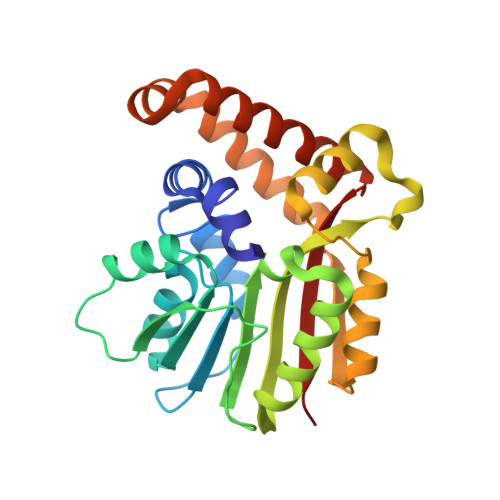An Alternative Mechanism for the Methylation of Phosphoethanolamine Catalyzed by Plasmodium falciparum Phosphoethanolamine Methyltransferase.
Saen-Oon, S., Lee, S.G., Jez, J.M., Guallar, V.(2014) J Biol Chem 289: 33815-33825
- PubMed: 25288796
- DOI: https://doi.org/10.1074/jbc.M114.611319
- Primary Citation of Related Structures:
4R6W, 4R6X - PubMed Abstract:
The phosphobase methylation pathway catalyzed by the phosphoethanolamine methyltransferase in Plasmodium falciparum (PfPMT), the malaria parasite, offers an attractive target for anti-parasitic drug development. PfPMT methylates phosphoethanolamine (pEA) to phosphocholine for use in membrane biogenesis. Quantum mechanics and molecular mechanics (QM/MM) calculations tested the proposed reaction mechanism for methylation of pEA involving the previously identified Tyr-19-His-132 dyad, which indicated an energetically unfavorable mechanism. Instead, the QM/MM calculations suggested an alternative mechanism involving Asp-128. The reaction coordinate involves the stepwise transfer of a proton to Asp-128 via a bridging water molecule followed by a typical Sn2-type methyl transfer from S-adenosylmethionine to pEA. Functional analysis of the D128A, D128E, D128Q, and D128N PfPMT mutants shows a loss of activity with pEA but not with the final substrate of the methylation pathway. X-ray crystal structures of the PfPMT-D128A mutant in complex with S-adenosylhomocysteine and either pEA or phosphocholine reveal how mutation of Asp-128 disrupts a hydrogen bond network in the active site. The combined QM/MM, biochemical, and structural studies identify a key role for Asp-128 in the initial step of the phosphobase methylation pathway in Plasmodium and provide molecular insight on the evolution of multiple activities in the active site of the PMT.
Organizational Affiliation:
From the Joint Barcelona Supercomputing Center-Centre for Genomic Regulation-Institute for Research in Biomedicine Research Program, Carrer de Jordi Girona 29, 08034 Barcelona, Spain.
















